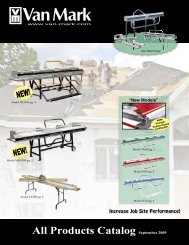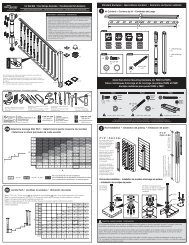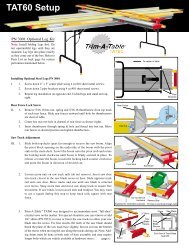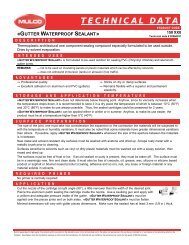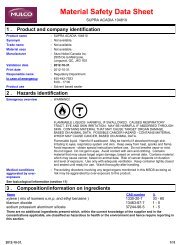M A T E R I A L S A F E T Y D A T A S H E E T - Henry
M A T E R I A L S A F E T Y D A T A S H E E T - Henry
M A T E R I A L S A F E T Y D A T A S H E E T - Henry
Create successful ePaper yourself
Turn your PDF publications into a flip-book with our unique Google optimized e-Paper software.
M A T E R I A L S A F E T Y D A T A S H E E TKL310BL - KOP-R-LASTIC BLACKPage 1 of 71. Product And Company IdentificationSupplierManufacturerHENRY COMPANYHENRY COMPANY909 N. Sepulveda Blvd., Suite 650 909 N. Sepulveda Blvd., Suite 650El Segundo, CA 90245-2724 El Segundo, CA 90245-2724Company Contact: Technical ServicesCompany Contact: Technical ServicesTelephone Number: (800) 486-1278 Telephone Number: (800) 486-1278Web Site: www.henry.com www.bakor.com Web Site: www.henry.com www.bakor.comSupplier Emergency Contacts & Phone Number Manufacturer Emergency Contacts & Phone NumberCHEMTREC: (800) 424-9300 CHEMTREC: (800) 424-9300CHEMTREC: (703) 527-3887 CHEMTREC: (703) 527-3887CANUTEC: (613) 996-6666 CANUTEC: (613) 996-6666Issue Date: 09/30/2011Product Name: KL310BL - KOP-R-LASTIC BLACKProduct Code: KL310BLProduct/Material UsesSealant2. Composition/Information On IngredientsIngredient CAS Percent OfName Number Total Weightcalcium carbonate 1317-65-3 10 - 20carbon black 1333-86-4 0.1 - 1ethyl benzene 100-41-4 5 - 10mineral oil 8012-95-1 5 - 15rubber compounds NA - Mixture 25 - 45silica, amorphous 112926-00-8 1 - 5xylene 1330-20-7 10 - 30Substances in this product have been pre-registered in accordance with the REACH Regulation - (EC) No. 1907/2006.See Section 15 for additional information.EMERGENCY OVERVIEWCAUTION! Vapor may cause light-headedness, headache, nausea, loss of coordination and respiratory tractirritation.Direct skin and eye contact may cause irritation. Ingestion may cause gastric distress.Appearance/Odor: liquid, solvent odor3. Hazards IdentificationPrimary Routes(s) Of EntryInhalation, skin absorptionEye HazardsMay cause eye irritation (burning, tearing, redness or swelling).
M A T E R I A L S A F E T Y D A T A S H E E TKL310BL - KOP-R-LASTIC BLACKPage 2 of 73. Hazards Identification - ContinuedSkin HazardsCauses skin irritation, possible defatting and dermatitis to skin.Ingestion HazardsMay be harmful if swallowed. May cause central nervous system depression, kidney damage, and liver damage.Symptoms may include: headache, excitement, fatigue, nausea, vomiting, stupor, and coma. Causes gastrointestinalirritation with nausea, vomiting and diarrhea. Aspiration of material into the lungs may cause chemical pneumonitis,which may be fatal. May cause gastric distress, vomiting and diarrhea. May cause irritation to the mouth, throat, anddigestive tract.Inhalation HazardsInhalation of vapors or mists may cause irritation of the nose and throat, headaches, nausea, dizziness, disorientaion,and numbness in fingers and toes.Chronic/Carcinogenicity EffectsThis product or one of its ingredients present at 0.1% or more is listed as a carcinogen by NTP, IARC or OSHA. SeeSection 11 (Toxicological Information) for more details.Chronic exposure can lead to permanent brain and central nervous sytem damage.Reproductive Hazard. May cause adverse reproductive effects.4. First Aid MeasuresEyeIn case of contact, hold eyelids apart and immediately flush eyes with plenty of water for at least 15 minutes. Getmedical attention immediately if irritation develops and persists.SkinRemove contaminated clothing and shoes. Wash affected areas with soap and water.IngestionGet medical attention immediately. DO NOT INDUCE VOMITING. Never give anything by mouth to an unconsciousvictim.InhalationRemove the person from the contaminated area to fresh air. If breathing is difficult, give oxygen. Contact a physician ifsymptoms develop.5. Fire Fighting MeasuresFlash Point: 75 °F 24 °CFlash Point Method: TCCLower Explosive Limit: not availableUpper Explosive Limit: not availableFire And Explosion HazardsFlammable liquid. During a fire, toxic and irritating gases may be generated, including carbon dioxide, and carbonmonoxide.Extinguishing MediaCarbon dioxide, water, water fog, dry chemical, chemical foam.Fire Fighting InstructionsKeep containers cool with water spray to prevent pressure build up and container rupture which could exacerbateexisting fire. Fire fighters should wear self-contained breathing apparatus and full protective gear.
M A T E R I A L S A F E T Y D A T A S H E E TKL310BL - KOP-R-LASTIC BLACKPage 3 of 76. Accidental Release MeasuresAvoid runoff to waterways and sewers. Contain and/or absorb spill with inert material (e.g. sand, vermiculite). Collectand dispose in accordance with applicable regulations.7. Handling And StorageHandling And Storage PrecautionsKeep containers tightly closed. Store in a cool, dry, well-ventilated area. Protect from physical damage. Protect fromextreme temperatures. Keep out of reach of children.8. Exposure Controls/Personal ProtectionEngineering ControlsUse with adequate general and local exhaust ventilation. When used outdoors, stay well away from building air intakes orclose and seal the intakes to prevent product from entering building.Eye/Face ProtectionIf there is a potential for splashing, faceshield over safety glasses or goggles.Skin ProtectionUse with chemical-protective gloves to prevent skin contact.Respiratory ProtectionThe level of respiratory protection needed should be based on the evaluation of chemical exposures by a health or safetyprofessional. If required, use a NIOSH-approved air purifying respirator with organic vapor cartridge and particulate filteror supplied air respirator. Respirator use may be required due to secondary operations such as mixing, spraying,sanding, buffing, etc.Occupational Exposure Limits for individual ingredients (if available) are listed below.Ingredient(s) - Exposure Limitscarbon blackACGIH TLV-TWA 3.5 mg/m3OSHA PEL-TWA 3.5 mg/m3ethyl benzeneACGIH TLV-STEL 125 ppmACGIH TLV-TWA 100 ppmOSHA PEL-TWA 100 ppmmineral oilACGIH TLV-STEL 10 mg/m3 (Notice of Intended Change)ACGIH TLV-TWA 5 mg/m3 (Notice of Intended Change)ACGIH TLV-TWA 0.2 mg/m3 (Proposed)OSHA PEL-TWA 5 mg/m3silica, amorphousOSHA PEL-TWA 80 mg/m3 / (%SiO2)xyleneACGIH TLV-STEL 150 ppmACGIH TLV-TWA 100 ppmOSHA PEL-TWA 100 ppm9. Physical And Chemical PropertiesAppearanceliquid
M A T E R I A L S A F E T Y D A T A S H E E TKL310BL - KOP-R-LASTIC BLACKPage 4 of 79. Physical And Chemical Properties - ContinuedOdorsolvent odorChemical Type: MixturePhysical State: LiquidBoiling Point: not available °F not available °CSpecific Gravity: 1.0Percent Volatiles: approximately 30Vapor Pressure: not availableVapor Density: >1pH Factor: not applicableSolubility: not solubleEvaporation Rate: not available10. Stability And ReactivityStability: stableHazardous Polymerization: not expected to occurConditions To Avoid (Stability)Keep away from ignition sources, heat, sparks and flames.Hazardous Decomposition ProductsDecomposition not likely to occur if handled and stored properly.11. Toxicological InformationChronic/CarcinogenicityIARC has concluded that the following chemicals in this product are possibly carcinogenic to humans (Group 2B): carbonblack, ethyl benzene.Mixed xylenes are considered fetotoxic, based on observations of reduced fetal weight, delayed ossification andpersistent behavioral effects in the absence of maternal toxicity. Other developmental effects have been observed in thepresence of maternal toxicity.Risk of cancer depends on duration and level of exposure to this product as a dust or aerosol mist.Miscellaneous Toxicological InformationToxicological testing has not been conducted for this product overall. Available toxicological data for individualingredients are summarized below.Ingredient(s) - Carcinogenicitycarbon blackListed In The IARC MonographsIngredient(s) - Toxicological Datacalcium carbonateLD50 (oral-rat) : 6450 mg/kgcarbon blackrat LC50: 6750 mg/m3 4-hr exposureethyl benzeneLC50 (rat) approximately 4000 ppm (4 hour)LD50 (oral rat) 3500 mg/kgLD50 (dermal rabbit) 15380 mg/kg (17.8 mL/kg)xylene
M A T E R I A L S A F E T Y D A T A S H E E TKL310BL - KOP-R-LASTIC BLACKPage 5 of 711. Toxicological Information - ContinuedIngredient(s) - Toxicological Data - ContinuedLD50 (oral, rat): 5400 mg/kgLD50 (dermal, rabbit): 12180 mg/kgLC50 (rat): 6350 ppm (4-hour exposure)12. Ecological Information13. Disposal ConsiderationsDispose in accordance with applicable federal, state and local government regulations.14. Transport InformationGround UN1133, Adhesives, 3, IIIIMDG UN1133, Adhesives, 3, IIIIATAUN1133, Adhesives, 3, IIIDOT (Pictograms)15. Regulatory InformationU.S. Regulatory InformationWarning: This product contains a substance(s) known to the State of California to cause cancer, birth defects or otherreporductive harm.SARA Hazard ClassesAcute Health HazardIngredient(s) - U.S. Regulatory Informationethyl benzeneSARA Title III - Section 313 Form "R"/TRI Reportable ChemicalxyleneSARA Title III - Section 313 Form "R"/TRI Reportable ChemicalIngredient(s) - State Regulationscalcium carbonatePennsylvania - Workplace Hazardcarbon blackNew Jersey - Workplace HazardPennsylvania - Workplace HazardCalifornia - Proposition 65Massachusetts - Hazardous Substanceethyl benzeneNew Jersey - Workplace HazardNew Jersey - Environmental HazardNew Jersey - Special HazardPennsylvania - Workplace HazardPennsylvania - Environmental HazardMassachusetts - Hazardous Substance
M A T E R I A L S A F E T Y D A T A S H E E TKL310BL - KOP-R-LASTIC BLACKPage 6 of 715. Regulatory Information - ContinuedIngredient(s) - State Regulations - ContinuedNew York City - Hazardous Substancemineral oilNew Jersey - Workplace HazardPennsylvania - Workplace HazardPennsylvania - Special HazardMassachusetts - Hazardous Substancesilica, amorphousNew Jersey - Workplace HazardPennsylvania - Workplace HazardMassachusetts - Hazardous SubstancexyleneNew Jersey - Workplace HazardNew Jersey - Environmental HazardNew Jersey - Special HazardPennsylvania - Workplace HazardPennsylvania - Environmental HazardMassachusetts - Hazardous SubstanceNew York City - Hazardous SubstanceCanadian Regulatory InformationThis product has been classified in accordance with the hazard criteria of the CPR and the MSDS contains all theinformation required by the CPR. WHMIS Classification: D2A - Very Toxic, B2 - Flammable Liquid.Ingredient(s) - Canadian Regulatory Informationcarbon blackWHMIS - Ingredient Disclosure Listethyl benzeneWHMIS - Ingredient Disclosure ListEuropean Union (EU) Regulatory InformationREACH Pre-registration Information:Substance (CAS#)Reference NumberCalcium Carbonate (1317-65-3) 05-2114501824-55-0000Silica, amorphous (112926-00-8) 05-2114501829-45-0000Xylene (1330-20-7) 05-2114367081-55-0000Mineral Oil (8012-95-1) 05-2114367014-56-0000Styrene Butadiene PolymerNA - Polymer (the monomers below have been pre-registered)-Styrene (100-42-5) 05-2114367032-58-0000-Buta-1,3-diene (106-99-0) 05-2114367037-48-0000WHMIS - Canada (Pictograms)
M A T E R I A L S A F E T Y D A T A S H E E TKL310BL - KOP-R-LASTIC BLACKPage 7 of 7NFPA32 0HMISHEALTH 2FLAMMABILITY 3REACTIVITY 0PERSONAL PROTECTION16. Other InformationRevision/Preparer InformationThis MSDS Supersedes A Previous MSDS Dated: 02/19/2011DisclaimerAlthough reasonable care has been taken in the preparation of this document, we extend no warranties andmake no representations as to the accuracy or completeness of the information contained therein, and assumeno responsibility regarding the suitablility of this information for the user's intended purposes or for theconsequences of its use. Each individual should make a determination as to the suitability of the informationfor their particular purposes(s).HENRY COMPANYPrinted Using MSDS Generator 2000



